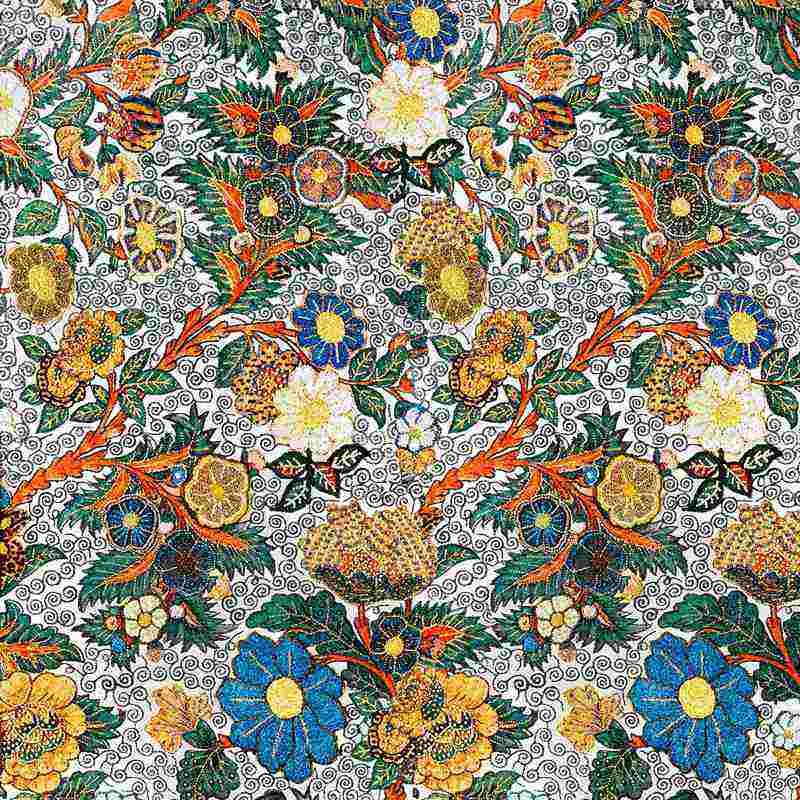Fabric printing in Iran plays a vital role in the country’s large textile industry. Iran’s designers draw on a rich heritage of textile arts while embracing modern methods. Many local printing houses now blend advanced technologies with traditional techniques to produce unique custom fabrics. Each method — from historic handcrafts to high-tech processes — offers distinct creative possibilities. Below are ten of the most popular fabric printing techniques every textile designer should know.
1. Block Printing
Block printing is a traditional method dating back centuries. An artist carves a wooden block with the desired pattern, dips it in dye or ink, and presses it firmly onto the cloth. Each carved block typically yields one color, so multi-colored patterns require multiple blocks. This hands-on approach creates an artisanal look, with slight irregularities adding to its charm. Block printing remains popular for decorative linens, ethnic wear, and boutique fabric collections.
2. Roller (Rotary) Printing
Roller printing uses engraved rollers to transfer ink onto fabric in a continuous process. Each roller applies one color, and multiple rollers can be used for complex patterns. This method is incredibly fast and efficient, making it ideal for large-scale production such as bed linens, drapery, and upholstery fabrics. While the setup costs are high, the speed and consistency make it a staple in industrial printing.
3. Screen Printing
Screen printing forces ink through a fine mesh stencil onto fabric. Areas that shouldn’t get ink are blocked out, while open spaces allow ink to pass through. Each color in the design requires its own screen. This method is known for vibrant, long-lasting colors and works well for bold, graphic patterns. It’s widely used for apparel, posters, and specialty textiles where color intensity matters.
4. Digital Printing
Digital printing uses computer-controlled printers to apply ink directly onto fabric. It allows highly detailed, multicolored designs to be printed without screens or plates. This method is perfect for short runs, custom designs, and photographic prints. It offers exceptional flexibility and speed, making it popular for on-demand production and experimental fashion lines.
5. Dye-Sublimation Printing
Dye-sublimation involves printing a design on transfer paper and then using heat to turn the dye into vapor, which bonds with polyester fibers. The result is a smooth, vivid print that becomes part of the fabric itself. This method is ideal for sportswear, scarves, and any application requiring durable, vibrant colors on polyester-based materials.
6. Pigment Printing
Pigment printing applies color pigments with a binder directly onto the fabric surface. It works on a variety of fibers, especially cotton, and produces bright, opaque colors. This method is cost-effective and requires no pre-treatment, though prints may feel slightly stiff and be less durable than other dye-based methods. It’s often used for fashion fabrics, home textiles, and accessories.
7. Reactive Printing
Reactive printing uses dyes that chemically bond with the fibers, creating soft, long-lasting colors. Fabrics are often pre-treated, printed, and then steamed to fix the dye. The result is a smooth finish with excellent wash resistance. Reactive printing is highly valued for high-quality cotton fabrics and is often chosen for premium apparel and home décor.
8. Transfer Printing
Transfer printing involves printing a design onto special paper and then transferring it to fabric using heat. This technique is simple and allows for full-color images, even with basic equipment. While it’s best suited for small runs or prototypes, the prints may sit on top of the fabric and can wear over time. It’s a go-to option for custom t-shirts, promotional items, and hobby projects.
9. Resist Printing (Batik and Tie-Dye)
Resist printing creates patterns by preventing dye from reaching certain areas of the fabric. In batik, wax is applied to block the dye, while in tie-dye, parts of the fabric are tied or bound. Once dyed, the resisted areas remain their original color, producing striking, organic patterns. These methods are deeply rooted in cultural traditions and are still embraced by contemporary designers.
10. Stamp Printing
Stamp printing uses carved stamps or simple shapes to apply ink or dye directly onto fabric. It’s straightforward, inexpensive, and ideal for creating simple, handmade patterns. While it lacks the precision of professional methods, it’s perfect for artisanal projects, small-scale production, and creative experimentation.
Bring Your Designs to Life with Expert Printing
Ready to bring your textile ideas to life? Whether you’re designing high-fashion scarves in Tehran or creating custom fabrics for international clients, the right printing method can transform your vision into reality. Get in touch with Azooni Printing and start turning your designs into stunning fabrics today — your next masterpiece is only a print away.




